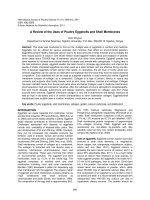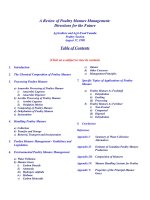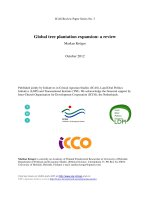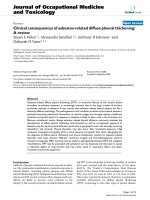Necrotic Enteritis: a Review pptx
Bạn đang xem bản rút gọn của tài liệu. Xem và tải ngay bản đầy đủ của tài liệu tại đây (2.63 MB, 66 trang )
Necrotic Enteritis: a Review
Dr. Aris Malo
Global Technical Manager
Boxmeer, the Netherlands
Condition caused by the toxins of
Clostridium perfringens
Results in damage of the intestinal mucosa
(thickened and lined with a
pseudomembrane; severe necrosis with
formation of diphteric membrane)
Economic losses:
• loss weight gain, higher time to market, poor
flock condition, increased mortality, increased
production costs (low feed conversion,
antibiotics), secondary infections, etc.Intestinal villi
x 62
Electron picture of VILLI: good!
x 62
Electron picture of VILLI: poor!Normal
Cholangiohepatitis
• Bacteria
• Rod-shaped
• Spore-forming
• Gram-stain positive
• Anaerobic
Clostridium lives in soil
…also poultry dust, feed, feces, litter.
Clostridium prefers high pH
Mississippi
River USA
…this is necrotic enteritis country
SE Asia
Egypt
Mexico
China
Europe
Anaerobic culture
• Use special anaerobic culture swabs
• Swab fresh intestinal contents or intestinal
wall
• Submit to lab ASAP to avoid overgrowth
• Samples in formalin.
• Do not take blood samples.
• New diagnostic kits????
Clostridium hemolyzes red blood cells
Clostridium produces toxins that attack
cells
______Toxin______
Cp
Type
A
B
C
D
E
++
+ + +
+ +
+ +
+ +
-
-
-
-
- -
-
-
- -
Associated Pathology
Diarrhea (foals, pigs…)
Necrotic Enteritis in poultry
Dysentery in newborn lambs
Hemorrhagic enteritis in newborn
calves and foals
Enterotoxemia in sheep
Necrotic enteritis in piglets, lambs,
calves, and foals
Enterotoxemia in sheep
Necrotic Enteritis in poultry
Enterotoxemia in lambs, sheep,
calves and goats
Enterotoxemia in calves
Present in normal intestinal microflora
Some may not be able to produce toxin
Natural non-toxin producing strain
May only produce toxin when “turned
on”
Eighth Edition of Diseases of Poultry
1984 Print
Chapter 13 - Miscellaneous Bacterial Diseases
–Botulism
–Other Clostridial Infections
–Gangrenous Dermatitis and Necrotic
Enteritis
“Incidence of infection is low and probably
depends on injury or infection to destroy tissue”
“Clostridial infections are not thought to be
common in birds, and economic loss is small”
Ninth Edition of Diseases of Poultry
1991 Print
• Chapter 11 – Clostridial Diseases
- Complete Sections on Gangrenous Dermatitis and
Necrotic Enteritis
• Current Poultry Industry Health Surveys
- Necrotic Enteritis Makes the “Top 5 List” in All of
Them
• Reduced weight
• Reduced growth rate
• Impaired FCR
• Mortality
• Morbidity
Clinical
Subclinical
Hofacre









